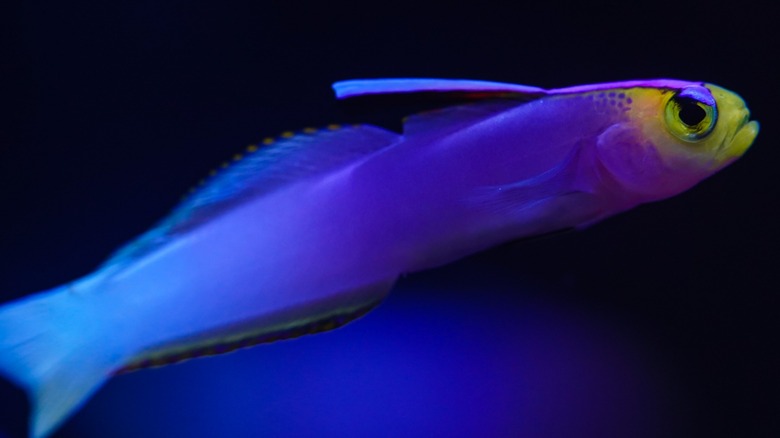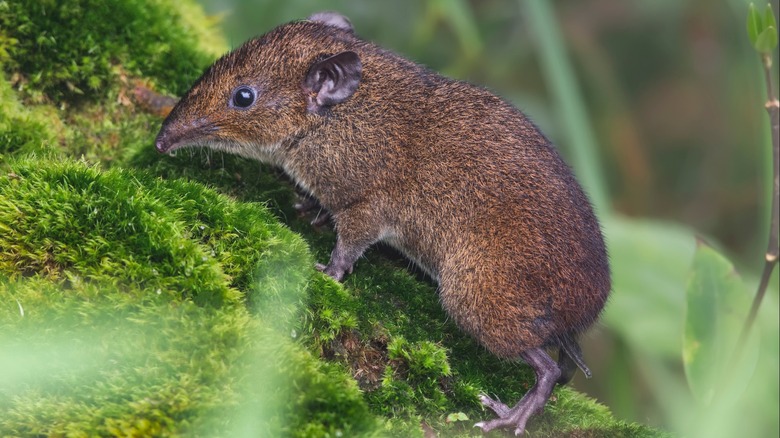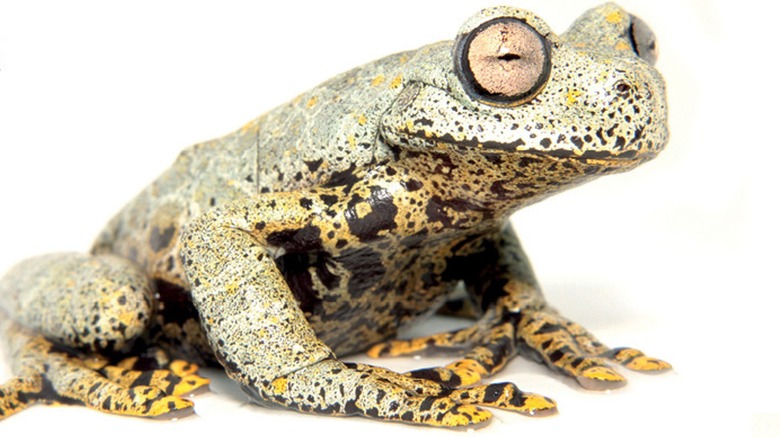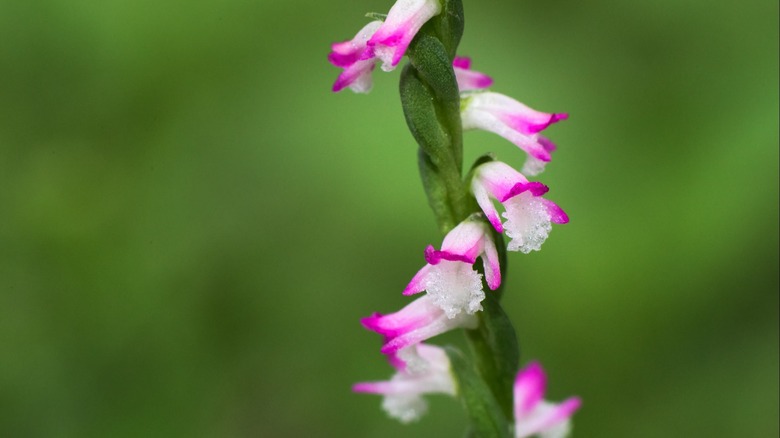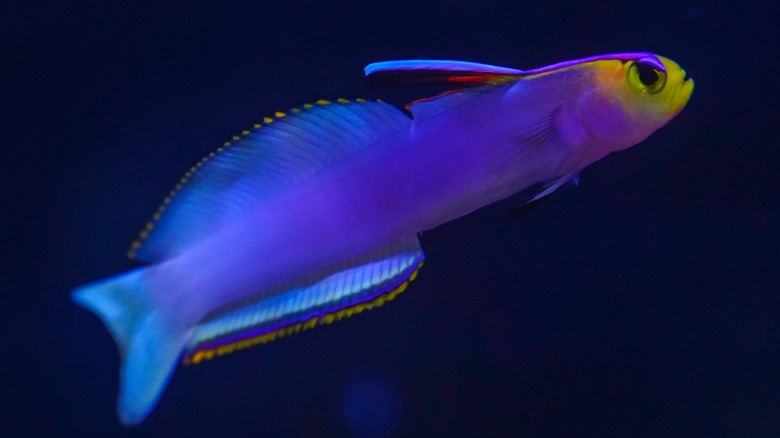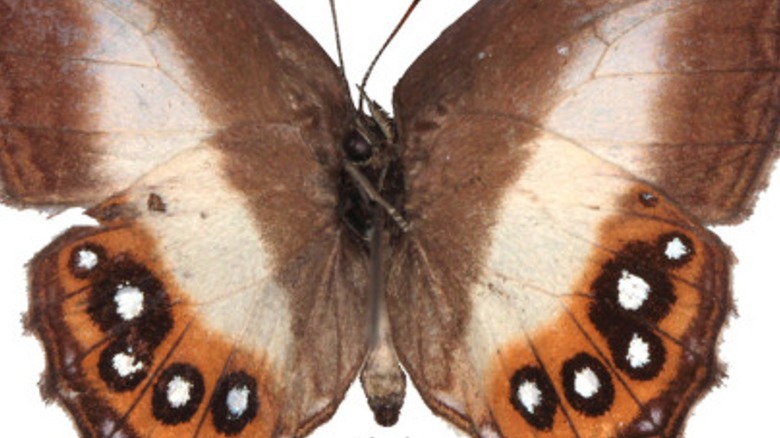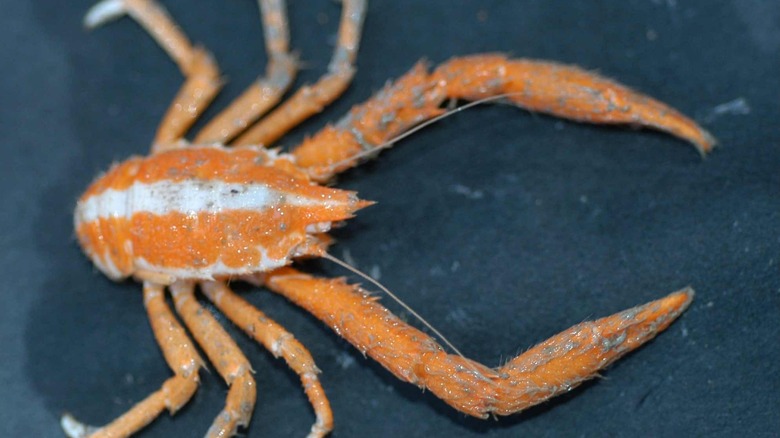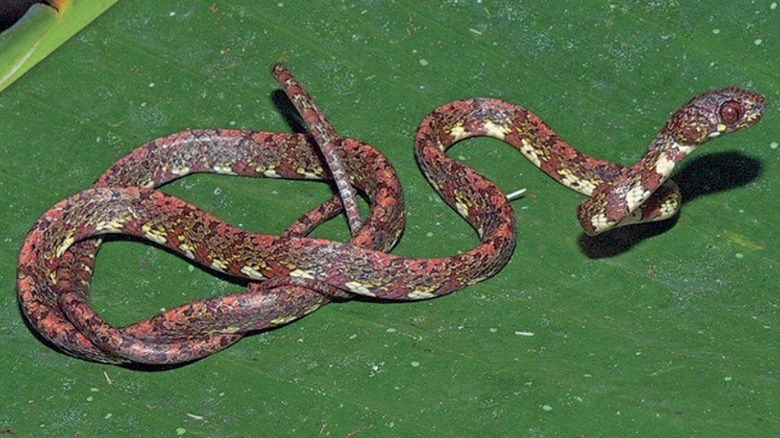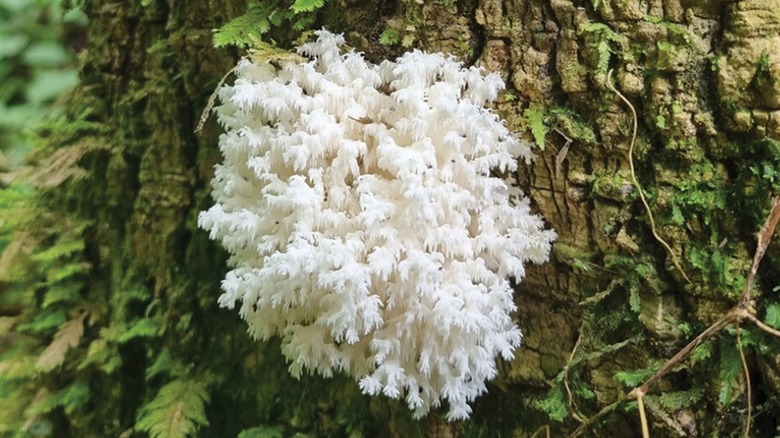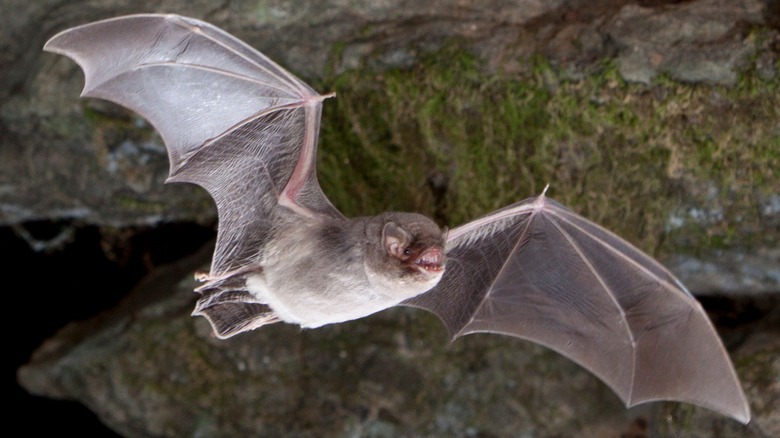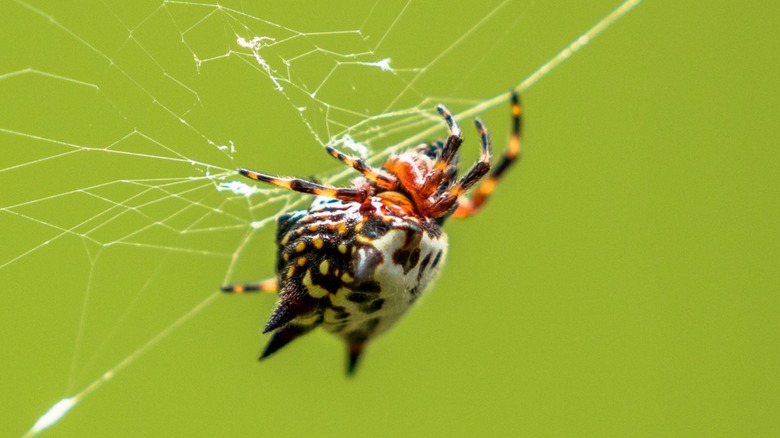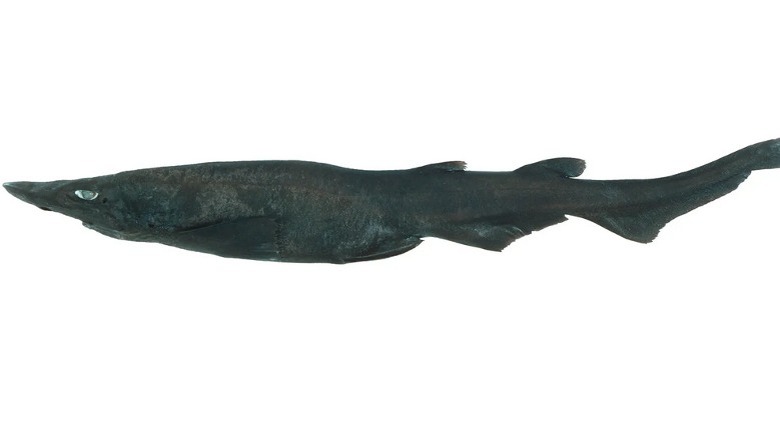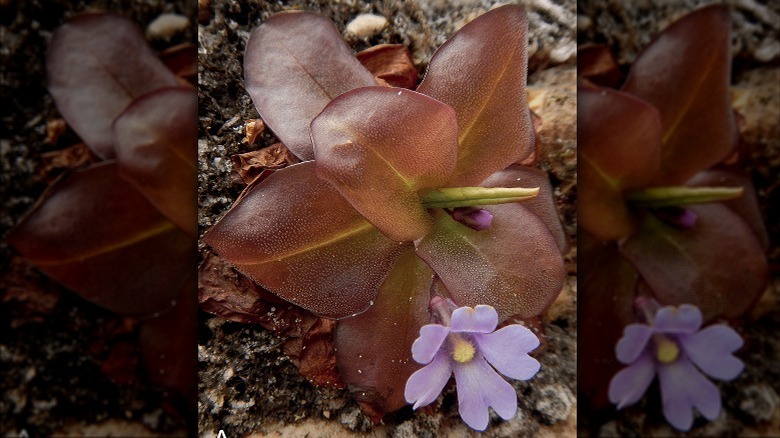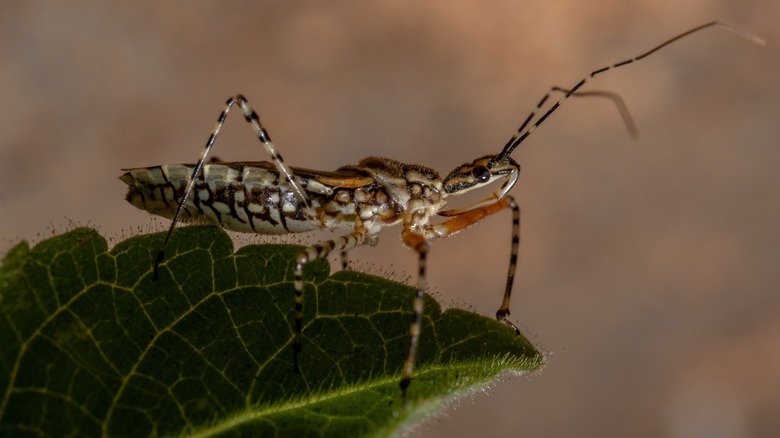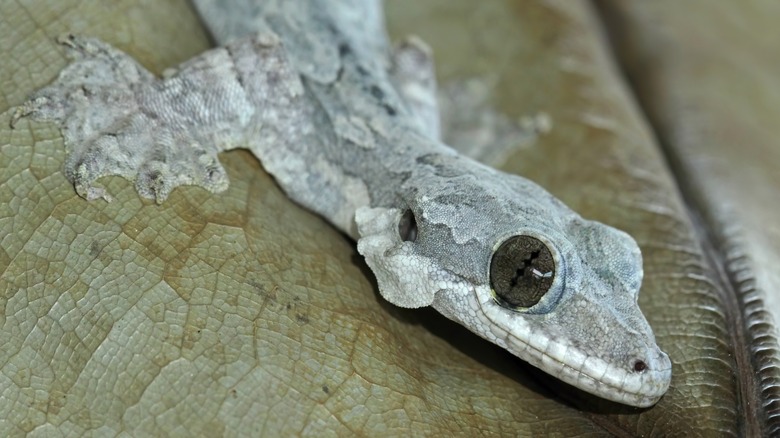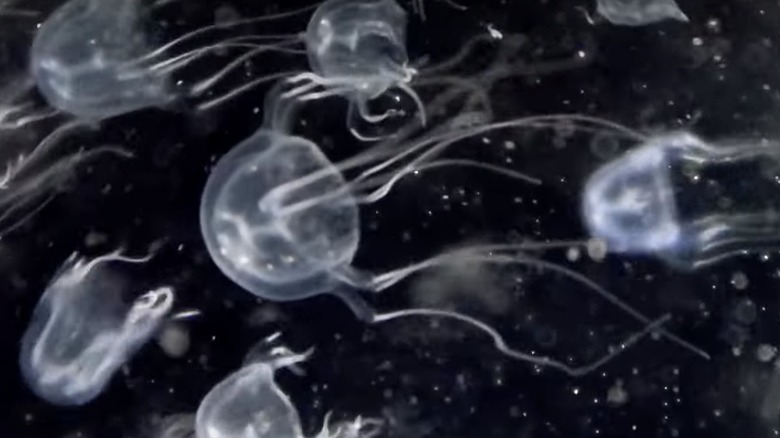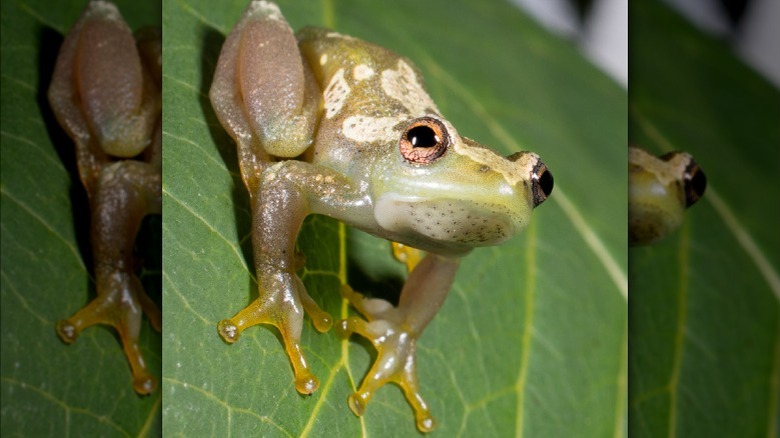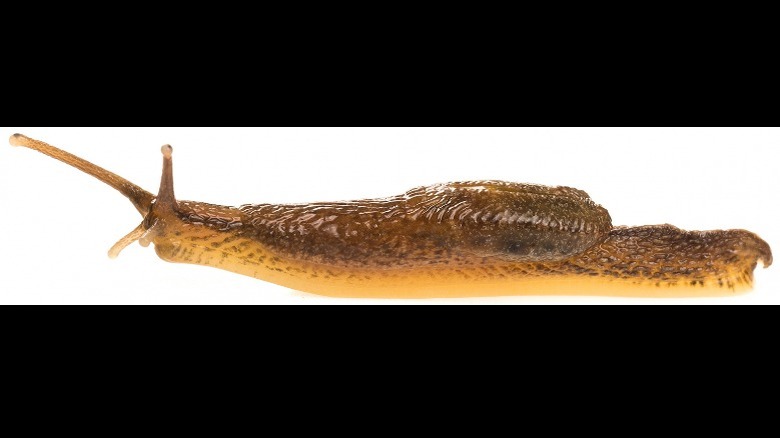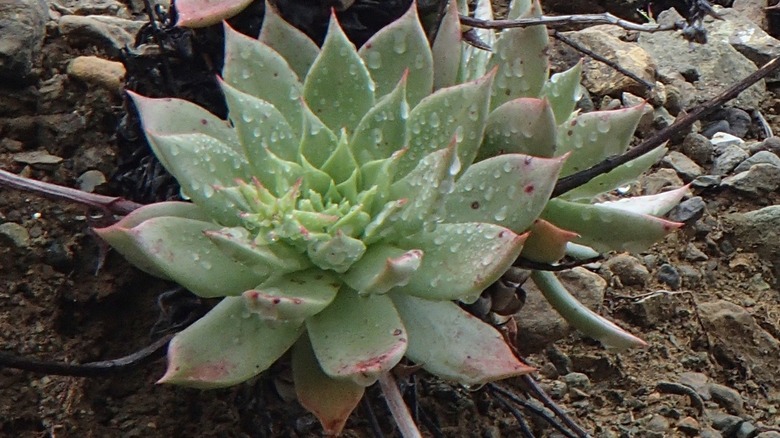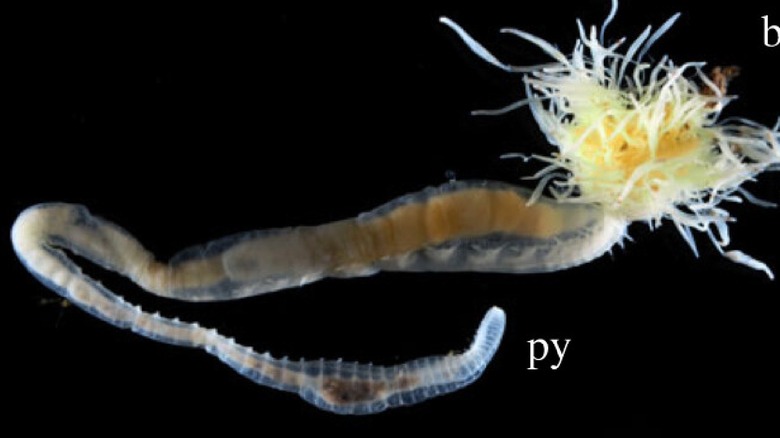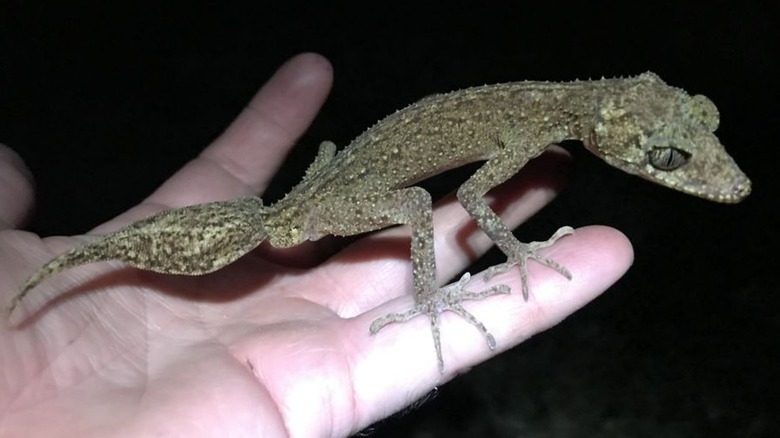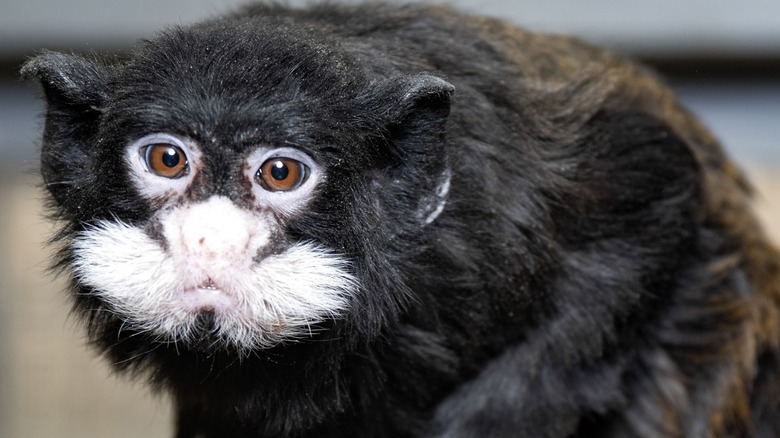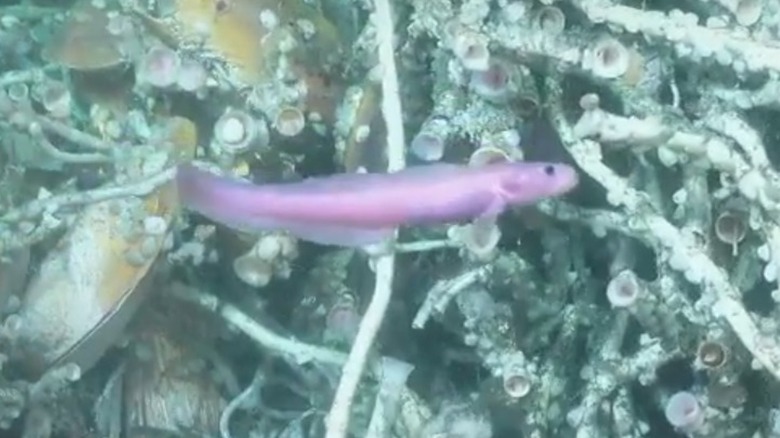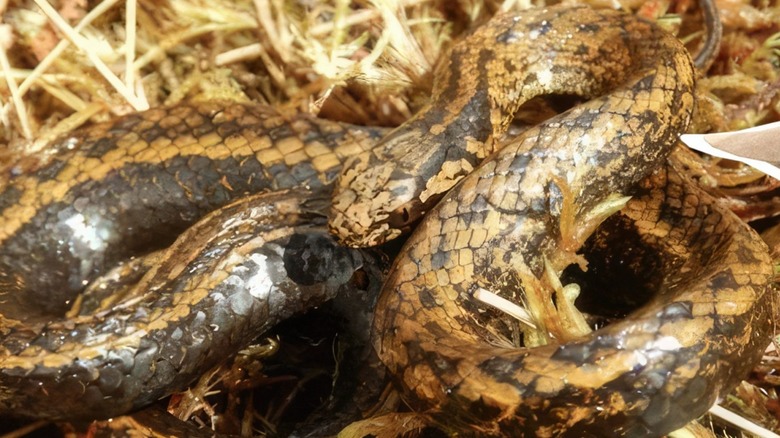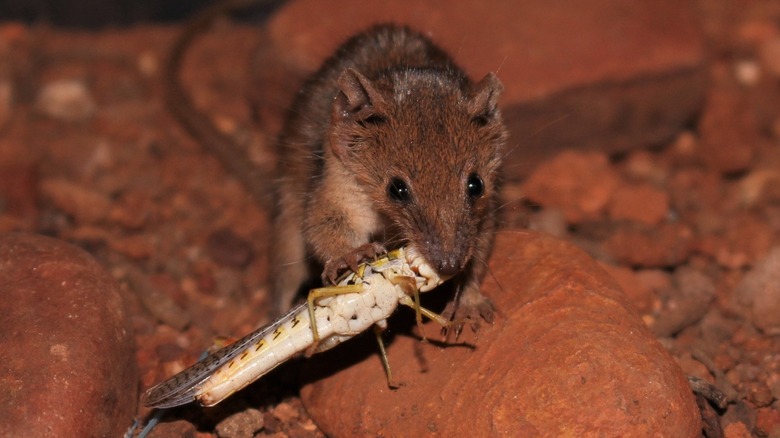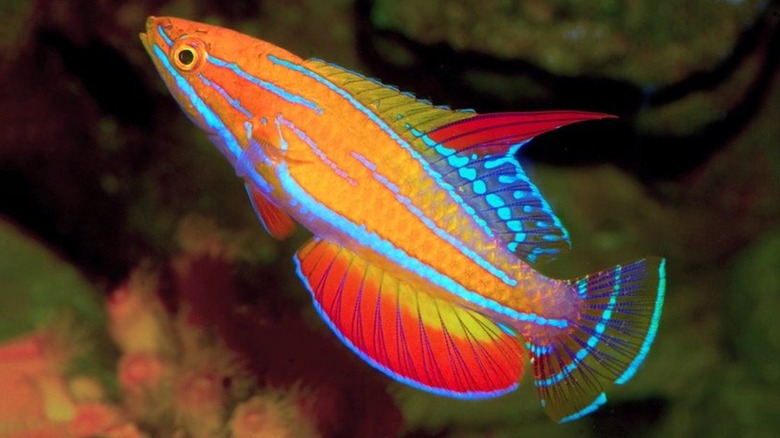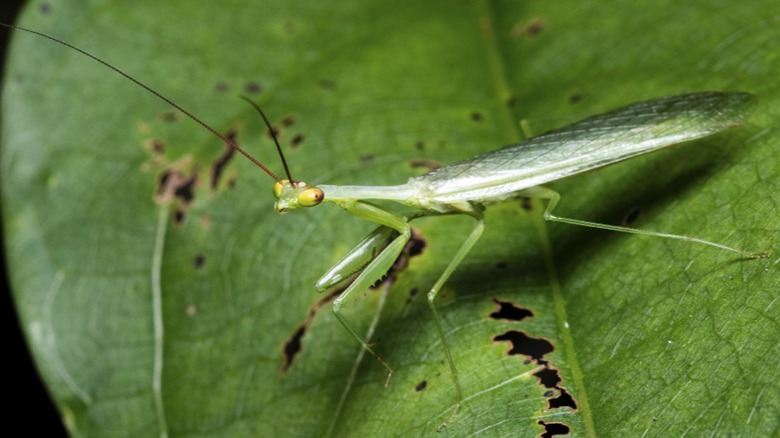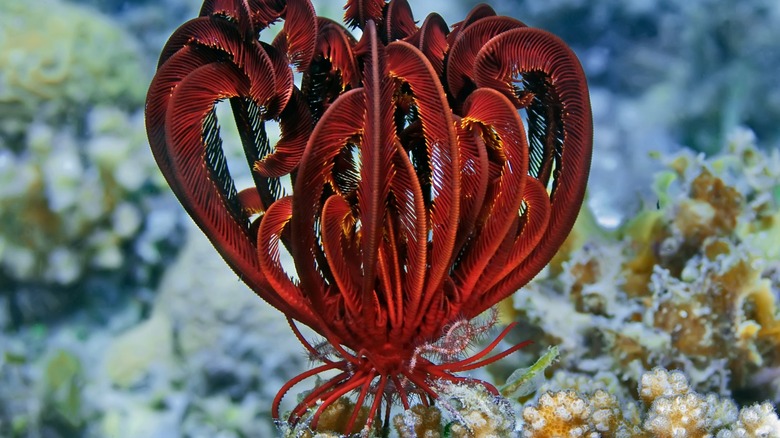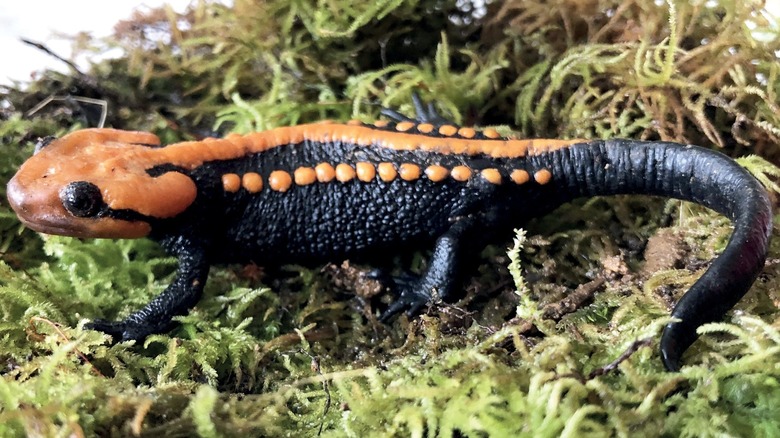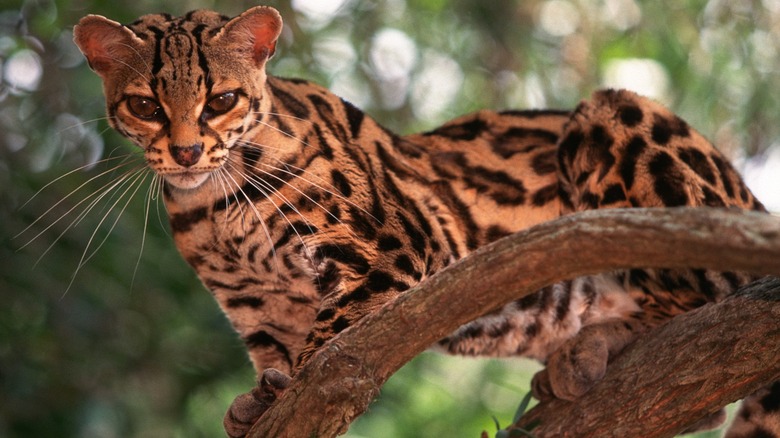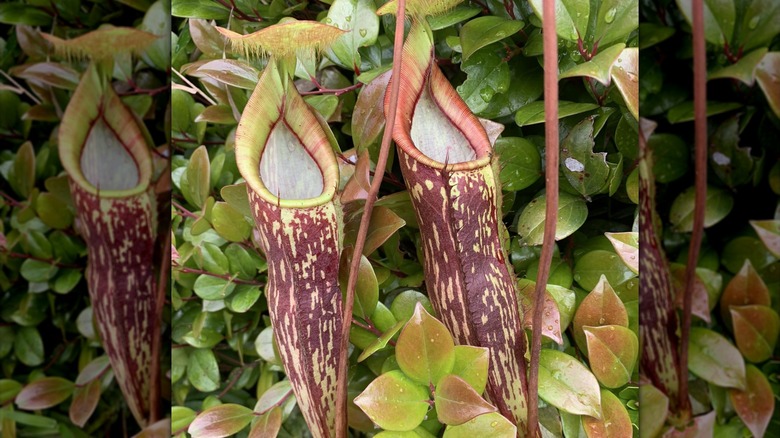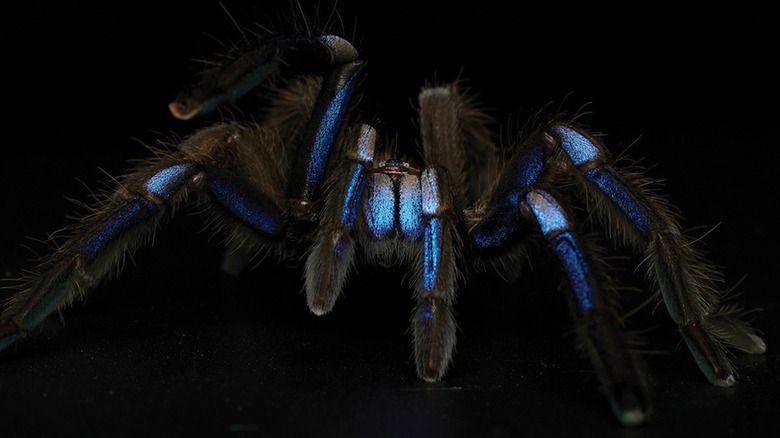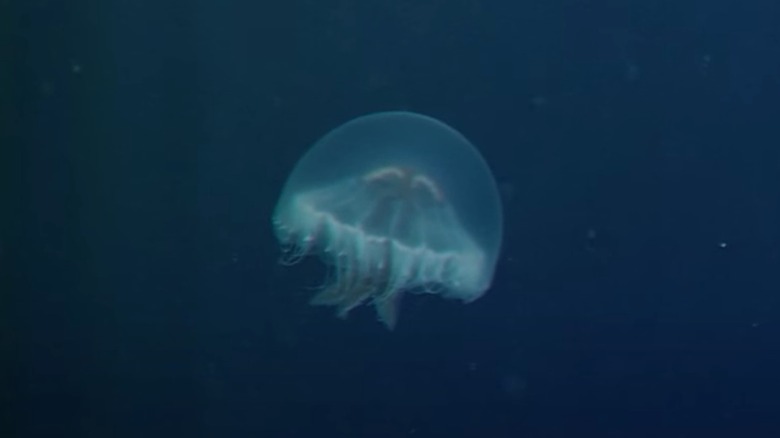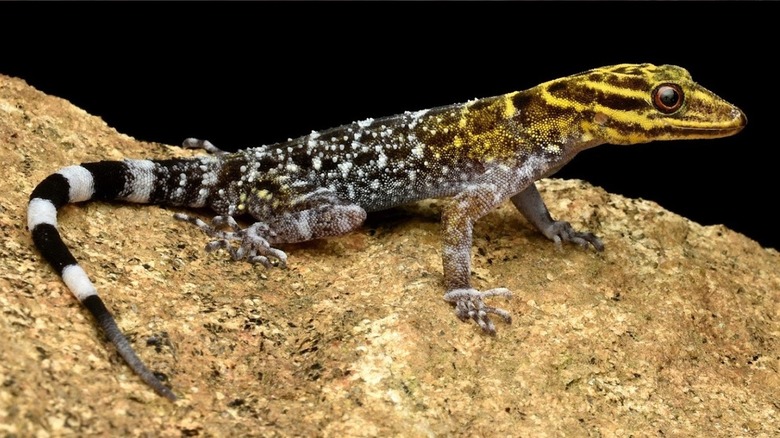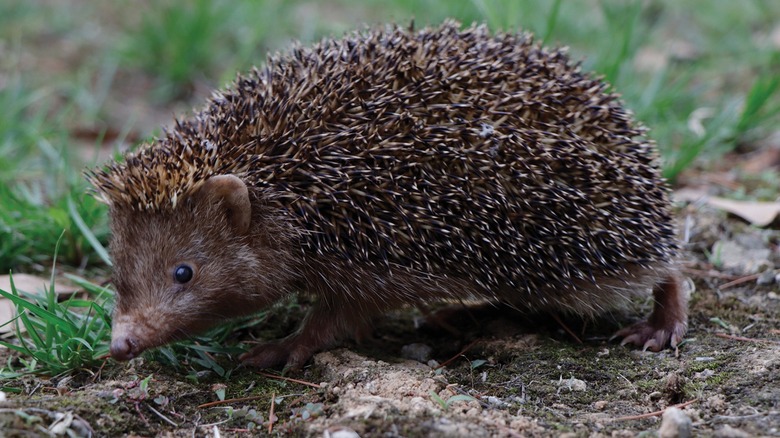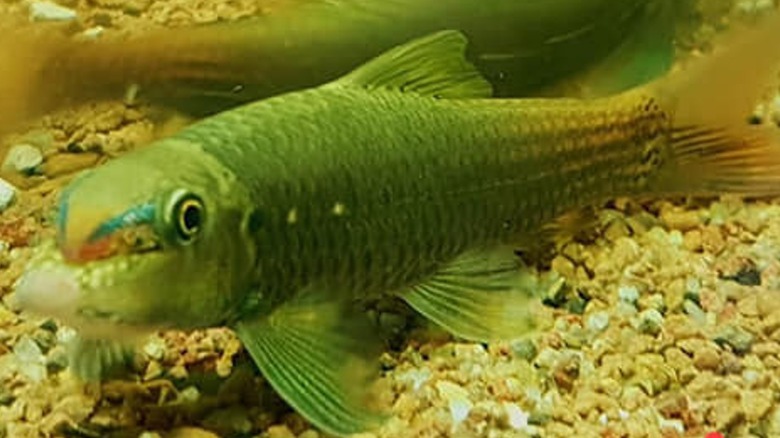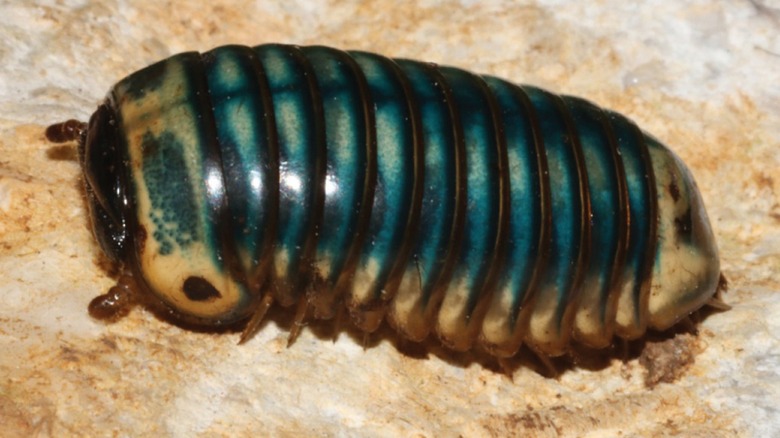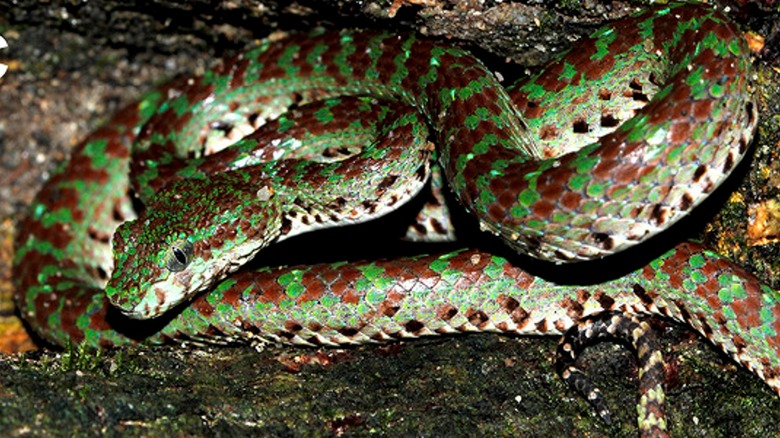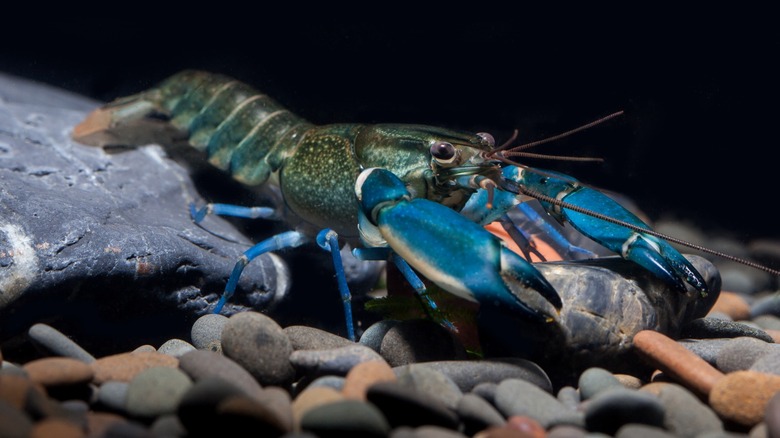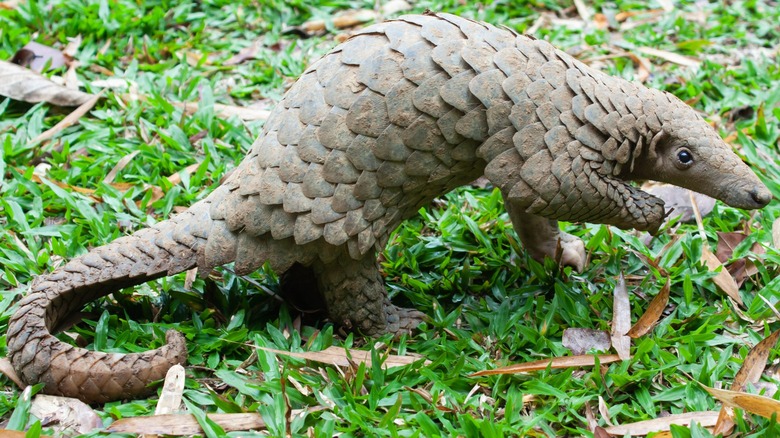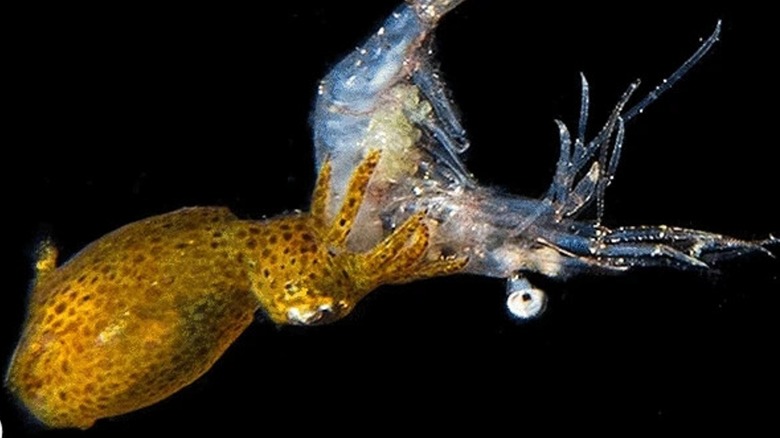40 Of The Most Fascinating Species Discovered In 2023
These days, most news about Earth's biodiversity is a real bummer. For example, a 2022 report published by the World Wildlife Fund found that animal populations across the globe have decreased by a catastrophic 69% between 1970 and 2018, primarily due to human-caused factors like habitat loss and climate change. And things aren't exactly on an upward trend. According to a 2023 study published in Biological Reviews, 48% of over 70,000 animal species surveyed are on a downward trajectory.
Birds, insects, mammals, and amphibians are especially impacted, with continued population declines prompting many biologists to announce the arrival of a sixth mass extinction event – this time due to what the study calls "Anthropocene defaunation," which is a fancy way of saying human activity is responsible for all this destruction. Plants and fungi – the foundation of all life on Earth – are also being lost at alarming rates. As a 2020 report by Kew Royal Botanic Gardens noted, 40% of plant species face extinction. And these are just the ones we know about!
Luckily, it's not all bad news. Scientists estimate that about 10% to 20% of Earth's species remain undiscovered. Diligent biologists working across the globe discover up to 18,000 new species each year, which opens doors for targeted conservation efforts and habitat preservation. From brand-new mammals to carnivorous plants to insects exhibiting previously unseen behaviors, there's plenty of proof that nature can still surprise us. Here are just a few of the most fascinating species discovered in 2023.
Eastern Mindanao gymnure
When it comes to the animal kingdom, mammals are pretty well-documented. But that doesn't mean there aren't a few unknown species lurking out there – especially in the world's most remote, unexplored places. According to a 2023 study published in Zootaxa, after surveying one such place – the isolated rainforest mountains of eastern Mindanao in the Philippines – biologists found an undescribed species of gymnure. What's a gymnure, you ask? It's a small long-nosed mammal that looks like a shrew but is actually more closely related to hedgehogs and moonrats.
Also called soft-furred hedgehogs, gymnures use their long snouts to probe the forest floor for their preferred prey: earthworms, insects, and other small critters. Biologists found that this new golden-streaked species, Podogymnura intermedia, hangs out on only two mountains: Mount Kampalili and Mount Hamiguitan. They suspect that a closely related species traveled to the island of Mindanao from Borneo around 2 to 3.5 million years ago, eventually evolving into the four species of Podogymnura known today.
Curiously, the two populations of eastern Mindanao gymnures differ slightly, with those living on Mount Kampalili having softer fur. It's possible that these, too, may someday evolve into two different species. "One of the highly distinct things about the Phillippines is that every isolated mountain ... has several species that occur nowhere else – not even on adjacent mountain ranges on the same island," one of the study's authors, Laurence Heanery, told BBC Wildlife Magazine. "If you don't go look, you don't know what is there."
Note: A different species of gymnure is pictured.
Río Negro stream treefrog
Of all the animals impacted by man, amphibians have it the worst. According to a 2017 study published in Climate Change Responses, they are especially susceptible to habitat loss, increased ultraviolet radiation due to ozone depletion, diseases, environmental pollutants, and acid rain – all of which are attributable to human activities. This makes the discovery of a new frog species even more exciting – and critical for its conservation.
The frog in question also happens to be quite a stunner. According to a 2023 study published in ZooKeys, biologists found the frog during a survey of the tropical forests of Río Negro-Sopladora National Park in southern Ecuador's Andes Mountains. They were so taken by the relatively large treefrog's bright colors and speckles that they named it Hyloscirtus tolkieini after renowned fantasy author J.R.R. Tolkien, writing: "The amazing colors of the new species evoke the magnificent creatures that seem to only exist in fantasy worlds."
The species was described based on a single specimen, meaning additional research is needed to determine its conservation status. Luckily, the frog's habitat is safe for the time being, as the over 75,000-acre Río Negro-Sopladora National Park was designated a protected area in 2018. Sticking to the magical theme, one of the study's authors, Diego F. Cisneros-Heredia, said in a statement (via Mongabay): "The truth is that the tropical Andes are true magical ecosystems where some of the most wonderful species of flora, fungi, and fauna in the world are present."
[Featured image by Juan C. Sánchez-Nivicela via Wikimedia Commons | Cropped and scaled | CC-BY-4.0]
Hachijojima ladies' tresses orchid
Biologists don't always have to travel to Earth's most remote places to find new species. According to a 2023 study published in the Journal of Plant Research, Japanese botanists discovered a new species of orchid growing in urban areas around Tokyo. That's right, it was hiding within a huge city. As it happens, Spiranthes hachijoensis was found growing in parks, planters, lawns, and gardens – essentially hiding in plain sight.
Like all orchids of the genus Spiranthes – commonly known as ladies' tresses orchids – it's a beautiful plant, named for its long, spiraled flower stalks that look like flowing locks of hair. This species also has tiny bell-shaped pinkish-purple and white flowers that reminded the researchers of intricate glass sculptures. You could definitely envision a fairy sipping out of one. Ladies' tresses orchids are a pretty common sight in Japan, but it turned out that what everyone assumed was just one species was actually two.
After analyzing its floral structures, evaluating its DNA, and observing when it flowered, the researchers realized that this plant blooming all around town was actually a new – and less abundant – species, a revelation that came with an important lesson. "The discovery of this new species hiding in mundane places demonstrates the need for persistent exploration even in seemingly unremarkable places," the study's lead researcher, Kenji Suetsugu, told Popular Science. "I think it's a discovery that reminds us that there is still an unknown world in nature that we come into contact with on a daily basis."
Lavender-blushed dartfish
In some cases, discovering a new species doesn't even involve leaving the house – or museum, as it were. Plenty of species are hiding out in existing collections and databases, just waiting to be found. As noted in a 2023 study published in the Raffles Bulletin of Zoology, Australian taxonomists found a whole new fish that way – and they didn't even need diving gear or a submarine to do it. After poring over museum specimens, reviewing underwater photographs, and performing some genetic analysis, they discovered that what was originally thought to be a single species of brightly colored dartfish was actually two, one of which hadn't been described before.
Upon closer examination, biologists realized that some fish had completely different colors and markings than the known species, the Helfrich's dartfish. For one, they didn't have a scowly dark mustache. The new species, an adorable little creature sporting a purple crown and bright yellow face, lives in coral reefs in the western and central Pacific Ocean. Due to its striking coloration, biologists named it Nemateleotris lavandula: the lavender-blushed dartfish.
Splitting one species into two has significant conservation implications. "Without careful taxonomy, we would have never known that there were two species hidden under one name," lead researcher Yi-Kai Tea told Newsweek. "Now that we do, we can re-assess their distributions, their statuses, and where to go from here. Putting a name to something is the first and most important step towards conservation. You cannot protect what we don't know exists."
Sauron butterflies
For some taxonomists, discovering one new species just isn't enough. And for those intrepid souls, the abundant insect kingdom awaits. According to a 2023 study published in Systematic Entomology, one international research team set out to make sense of a giant grouping of neotropical butterflies called the Euptychiina tribe. Though the tribe contains over 400 known species, it is often overlooked in favor of more charismatic butterflies. You see, Euptychiina butterflies are kind of boring. They're pretty small and most are predominantly a drab brown in color.
Diligent researchers across the globe spent a decade studying around five and a half million collected Euptychiina specimens, carefully extracting DNA from the insects and using advanced genetic techniques to analyze taxonomic relationships. And what did they get for all their trouble? Several new genera and many new species. The researchers were especially taken with one new genus, which they named Saurona after fantasy author J.R.R. Tolkien's famous "Lord of the Rings" villain.
Both Saurona species feature bright orange and black eyespots on their hindwings, which, after hours in a lab, could start evoking images of the fire-rimmed Eye of Sauron. But the name wasn't chosen just for fun. "Butterflies are under enormous pressure from habitat loss, and we desperately need to identify and study new species before time runs out for them," researcher Blanca Huertas explained to The Guardian. "By giving them unusual names, we can bring attention to what is happening to butterflies, which are in real trouble across the world today."
[Featured image by Espeland, M., Et al. via Systematic Entomology | Cropped and scaled | CC BY 4.0 ]
Deep-sea squat lobsters
While the name "squat lobster" might not equal "fascinating" in most peoples' minds, these little crustaceans are actually pretty impressive. They are extremely diverse, with many living in the abyssal deep sea, a high-pressure, pitch-black, and generally mysterious realm that occurs 9,842 to 22,325 feet below the surface. Even in modern times, the deep ocean remains largely unstudied due to its extreme inaccessibility. So, how do biologists discover new squat lobsters?
According to a 2023 study published in Invertebrate Systematics, they were collected by the human-operated submersible vehicle, Alvin, famous for exploring the Titanic. Alvin features suction devices and robotic arms, allowing it to gather samples. Amazingly, the creatures were captured alive, enabling biologists to photograph, study, and harvest DNA from them. Overall, the effort resulted in five new species of squat lobster of the genus Munidopsis – including one that was collected way back in 1990.
Squat lobsters are close relatives of hermit crabs named for their tucked-under tails, which give them a compact folded-up shape. They frequently hang out around hydrothermal vents, cold-water reefs, and "whale falls" – or sunken whale carcasses – at great depths. "We still do not know how many species live in our world, especially marine invertebrates living in the deep sea," lead researcher Paula Rodríguez-Flores told Harvard's Museum of Comparative Zoology. "We need to continue to explore the deep ocean, collecting more specimens, to have a complete picture of the distribution range and evolution of animals in the abyss before they disappear."
Note: A different species of Munidopsid squat lobster is pictured.
DiCaprio's snail-eating snake
Sadly, some species are already facing extinction upon their discovery. As researchers noted in a 2023 study published in ZooKeys, all five of the snail-eating snake species they found in the tropics of Panama, Ecuador, and Colombia were in trouble. And, oddly enough, COVID-19 is partially to blame. Economic struggles during the pandemic drove many people to take up illegal gold and copper mining, creating large barren pits along forest waterways and polluting streams and rivers. Large sections of rainforest are also being cleared to build infrastructure for workers and equipment, making a bad situation worse. And it's still happening.
While this disruption harms countless plants and animals, snail-eating snakes have a particularly rough time because they live in trees and feed on snails and slugs, which can only survive in wet, toxin-free environments. "These [snake] species are delicate and used to living in very humid parts of the forest," one of the study's researchers, Abel Batista, told Mongabay. "Once we open the forest, if they don't have a place to go, they just die."
To help draw attention to the snakes' urgent plight, the researchers enlisted the aid of actor and conservationist Leonardo DiCaprio, who helped name three of the small brightly colored snakes. He named the rarest one, Sibon irmelindicaprioae, after his mother, Irmelin DiCaprio. As study researcher Alejandro Arteaga explained to Mongabay: "Both legal and illegal open-pit mines are uninhabitable for the snail-eating snakes – and most everything else that lives there, too."
[Featured image by A. Arteaga and A. Batistavia via ZooKeys 1143 | Cropped and scaled | CC BY 4.0 ]
Ophelia's mushroom
Sometimes, species remain undiscovered simply because no one goes looking for them. Such was the case when a microbiologist named Breyton Van der Merwe happened upon an unusual white mushroom while on a January stroll in the temperate forests of South Africa. Even wilder? He was just a student at the time. According to a 2023 study published in Mycology, Van der Merwe had found a new species of mushroom in the genus Hericium – only the second such fungus known to exist in Africa.
Researchers named the new mushroom Hericium ophelieae after Arthur Rimbaud's French poem "Ophélie," which depicts the death of Shakespeare's "Hamlet" character Ophelia. Rimbaud's elegiac lines like "long veils," "beautiful as snow," and "white phantom" perfectly described the ghostly mushroom's wispy fruiting body, which grows only on the decaying trunks of a few hardwood tree species in South Africa's Knysna-Amatole forests during the rainy season. And, while that's plenty exciting all on its own, the discovery has even greater implications.
Hericium mushrooms have long been prized for their medicinal and nutritional uses. In fact, one species – the lion's mane mushroom – has been used as both food and traditional medicine in China for centuries. As Breyton Van der Merwe, the researcher credited with discovering the mushroom, told McClatchy News (via Yahoo!): "Several unique medicinal compounds have been described from Hericium species, and these compounds have been used in studies as treatments for everything from neuropsychiatric disorders like depression to cancer, and even anti-aging treatments."
[Featured image by T. Conradie and B. Van der Merwe via Mycology | Cropped and scaled | CC BY 4.0 ]
Srini's bent-winged bat
Owing to their mostly-nocturnal lifestyles and habit of hanging out in hard-to-reach places like caves, bats can be pretty hard to study – and that makes finding a new one even more exciting. Zoologist Bhargavi Srinivasulu and her equally academic son, Ph.D. researcher Aditya Srinivasulu, found some small bats while exploring an underground cave located deep in the dense jungles of the Western Ghats – an understudied mountain range in southwestern India.
According to her study, published in Zootaxa in 2023, the bats found in the cave were superficially pretty similar to an existing species of bent-winged bat, but further analysis of their echolocation calls, anatomical measurements, and genetics revealed that they were actually a different species. Bent-winged bats are named for the way they fold their extremely long wings when resting. They roost in colonies several hundred strong by day, emerging at dusk to feast on flying insects like moths. All in all, describing the new "cryptic species" – so-named for the fact that it looks almost identical to another species but is genetically quite distinct – took around six years.
With the publication of the study, Bhargavi Srinivasulu received the honor of having the species, Miniopterus srinii or Srini's bent-winged bat, named after her. "Our research on Andaman bats revealed that the fauna on the islands are genetically different from those on mainland India," she told the Deccan Chronicle. "In India, four species of bent-winged bats are known. With our discovery, the number has increased to five."
Note: A different species of bent-winged bat is pictured.
Malagasy kite spider
Some of the coolest new species are found completely by accident. While studying a different species of spider in Madagascar, researchers happened upon a bizarre scene: a bunch of male spiders sharing a web and hanging out together. According to their 2023 study published in Insect Systematics and Diversity, the researchers first spotted the spider gatherings from a moving car and immediately jumped out to investigate.
The gregarious arachnids turned out to be a type of box kite spider, which are small web-spinning spiders known for their square backs, bright colors, and spiny protuberances. And not only were they a new species – Isoxya manangona – but their behavior was totally unusual for spiders. The researchers observed 22 different "colonies," each featuring up to 21 individual female webs connected like a spider sorority. In the middle of the network was a single line of web, on which up to 38 males perched together.
Even stranger, the males weren't being aggressive toward each other – something practically unheard of in the spider world, which is typically solitary at best, and, at worst, cannibalistic. In fact, out of around 50,000 known spider species, less than 0.1% are social. Researchers believe that the unusual behavior is a form of lekking, in which male animals gather to display for females. If proven, this will be the first time lekking has ever been documented in spiders. As lead researcher Igni Agnarsson told Entomology Today: "Further research is necessary but is bound to find something fascinating."
Note: A different species of box kite spider is pictured.
Ridged-egg catshark
Biologists have long suspected that there was an undiscovered species of demon catshark lurking off the coast of Western Australia, but they never had quite enough information to solve the puzzle – until very recently. According to a 2023 study published in the Journal of Fish Biology, the first evidence of the mysterious shark came in the form of an egg case found decades ago.
Shark egg cases, sometimes called "mermaid's purses," come in a variety of shapes and sizes and usually feature stringy tendrils that help anchor them, allowing the young sharks within to hatch in ideal environments. In the case of this shark, researchers only had two uniquely ridged egg cases to work with – one found back in 1989 and another in 2011 – and they didn't match those of any known species. So, in order to solve the mystery, they had to get creative.
Biologists performed surgery on a misidentified pregnant museum specimen. Inside, they found an egg case that matched the two previously collected, confirming that this was, indeed, a new species. The new demon catshark, which they named the ridged-egg catshark (Apristurus ovicorrugatus), has unusual glowing white eyes that give it an ominous look. It lives at depths of over 2,200 feet and researchers believe that it lays its eggs on coral. "We just know very little about deepwater fauna in Australia," lead researcher Will White told ABC News. "As more deepwater surveys continue, I think we'll uncover more species records – there's still a lot to come."
[Featured image by Leoblade56 and CSIRO Australian National Fish Collection via Wikimedia Commons | Cropped and scaled | CC BY-SA 4.0]
Carnivorous butterwort plants
What's even more fascinating than carnivorous plants? New-to-science carnivorous plants. And there's good news: botanists have found not one but two new species of butterwort! According to a 2023 study published in PhytoKeys, both species were discovered high in the tropical Andes Mountains of southern Ecuador. One, Pinguicula jimburensis, lives on the marshy shores of a highland lagoon while the other, Pinguicula ombrophila (pictured), lives on steep limestone cliff faces.
Unlike most plants, butterworts thrive in harsh environments with nutrient-poor soil. For these plants, it's "no nutrients, no problem" as they extract everything they need from their insect prey, which they trap on their sticky basal leaves. They also produce attractive two-lipped flowers on raised stalks, which have made a few species popular in the horticultural trade. Both new butterwort species rely on wet environments, deriving moisture from rainfall and fog. In fact, one of them – Pinguicula ombrophila – is even named for it, with its specific epithet "ombrophila" translating to "rain-loving" in Latin.
Because of this – and the fact that each is known from only a single location – both species are more sensitive to environmental disturbance, habitat loss, and climate change and are already considered at risk of extinction. "Even in well-known groups such as the carnivorous plants, new taxa are continuously discovered and described, in particular from remote areas that become accessible in the course of the unlimited urban sprawl," the researchers wrote in the study. "This is both encouraging and worrying at the same time."
[Featured image by Álvaro J. Pérez via PhytoKeys | Cropped and scaled | CC BY 4.0 ]
Australian assassin bug
Discovering a new bug species is pretty cool, but discovering a new bug behavior is even cooler. And, believe it or not, researchers in Australia did both this year. According to a 2023 study published in Biology Letters, it all started when ecologist Fernando Soley noticed an insect covered in resin while walking through a Western Australian savanna. Upon closer inspection, the insect – a type of assassin bug – seemed to be intentionally applying the resin to its front forelegs with all the gusto of a beach-goer putting on sunblock.
Intrigued, Soley set out to test his theory that the insects were using sticky resin from spinifex grass to catch prey. You see, assassin bugs are aptly named. They are sit-and-wait predators that rely on stealth and camouflage to catch their unsuspecting insect victims. Soley's hypothesis that the resin helped them turned out to be true, with resin-coated bugs catching more insects than their scrubbed counterparts. The resin, therefore, served as a tool to catch prey.
Tool use is often regarded as an indicator of intelligence typically found only in mammals and birds. And, while Soley's research noted that the assassin bugs used resin instinctively, it's still pretty neat to see an insect employing such an effective hunting strategy. What's more, the assassin bug in question turned out to be a new species. "The resin clearly functions as a tool," lead researcher Fernando Soley told PNAS, adding, "I don't want to exaggerate and say that they are smart."
Note: A different species of assassin bug is pictured.
Mizoram parachute gecko
Typically, far fewer vertebrates are discovered each year than, say, insects or plants. But geckos are the exception. In fact, 28 new geckos were described in a single paper in 2022. While many gecko species have already been discovered in 2023, this one might just be the most fascinating because, well, it can fly – kind of. As announced in a 2023 study published in Salamandra, researchers found a new species of parachute gecko in the Indian state of Mizoram.
Like others in this unique lizard group, which are also called flying geckos, Gekko mizoramensis is a nocturnal lizard that uses flaps of body skin to "fall with style" – sometimes for distances of up to 200 feet – to both escape predators and glide from tree to tree in its tropical forest home. At around 8 inches long, it's pretty noticeable – especially when it ventures into urban areas and lands on the side of buildings.
As is often the case in nature, the new gecko hid in plain sight for years because it looked nearly identical to another flying gecko, making it what biologists call a "cryptic species." But, after analyzing the lizard's DNA, researchers confirmed that it was genetically distinct. Because its full range is still unknown, protecting what could be a rare species is vital. "There is a lot of superstition and mythological belief in Mizoram," lead researcher Hmar Tlawmte Lalremsanga told India Today. "The people here usually hunt so it is very important to spread awareness."
Note: A different species of parachute gecko is pictured.
Mai Po box jellyfish
Box jellyfish – also known as sea wasps – are well known for their potent venom. In fact, one species, the Australian box jellyfish, is considered the most dangerous marine animal in the world. And now, according to a 2023 study published in Zoological Studies, biologists have discovered a new box jelly swimming among the mangroves in Hong Kong's Mai Po Nature Reserve. Because it was repeatedly collected in the brackish area's intertidal shrimp ponds, it likely also lives in the adjacent Pearl River Estuary.
Tripedalia maipoensis is the first box jellyfish ever discovered in China. Like all box jellies of its genus, it has a transparent cube-shaped body and paddle-shaped tentacles that allow it to swim faster than other jellies. It also has an array of 24 eyes, which occur in clusters of six. In each grouping, two eyes are able to resolve images while four can only sense light. The species is unique for its body's forked water canals, which it uses for propulsion, tentacle arrangement, and genetic makeup.
At only 1.5 inches long, it likely feeds on small creatures called copepods, which it subdues with its venom – though it remains to be seen what its sting does to people. "We are thrilled with this discovery," lead researcher Qiu Jianwen told Hong Kong Baptist University. "Finding a new species in Mai Po, where extensive research has been conducted, highlights the potential for more marine life discovery in the Hong Kong and even the Chinese coastal waters."
Ukaguru spiny-throated reed frog
On occasion, researchers set out to study one species only to discover a totally different one in the process. Such was the case when biologists searching for a critically endangered tree toad in the Ukaguru Mountains of central Tanzania stumbled upon a mysterious little golden frog instead. Even wilder? It was a brand-new species – and an unusual one at that.
According to a 2023 study published in PLOS ONE, this species doesn't croak or call like most other frogs. Rather, males likely attract mates with a series of small spines on their throats, which researchers believe the frogs use as a kind of Braille. As a result, the media took to calling it the "silent frog," though its official name is Hyperolius ukaguruensis. It can be distinguished from other spiny-throated reed frogs by its golden coloration, genetics, and relatively small eyes.
The Ukaguru Mountains are considered "sky islands" – a type of biological hotspot in which one ecosystem is surrounded by a radically different habitat type, isolating the species that live there. The tropical rainforest mountaintops, therefore, become like islands in a sea of savanna, giving rise to unusual species found nowhere else on Earth. "The Ukaguru Mountains are part of the greater Eastern Arc Rift, a fascinating cradle of biodiversity, with many species endemic to single mountain blocks," study researcher H. Christoph Liedtke said in a press release. "The fast population growth in Tanzania means that the mountain forest habitats are under growing threats from people."
[Featured image by C. Liedtke via PLOS ONE | Cropped and scaled | CC BY 4.0 ]
Salleh's semi-slug
Some regions are so biodiverse that even a quick visit all but guarantees a new species discovery. That was the thinking behind a series of survey expeditions to the rainforests of northern Borneo Island, which consisted of a rag-tag group of biologists, citizen scientists, students, and everyday Joes. The venture paid off. According to a 2023 study published in the Biodiversity Data Journal, the group found a new species of semi-slug crawling around on vegetation at night and after rains.
Also called "snugs," semi-slugs are strange small-shelled missing links in the mollusk world, bridging the gap between slugs and snails. The species was first identified based on its unique shell and genitals, which are, oddly enough, a great way to identify slugs. After taking photos and descriptions of living specimens, portable genetic kits were used to sequence the semi-slug's genomes right there in the field. The creature was named Microparmarion sallehi after Md Salleh Abdullah Ba, who led the expeditions hosting the exciting find right before retiring.
The new semi-slug is proof that anyone can discover a new species. "We hope to spread a sense of the importance of basic taxonomic discovery among the general public, who all too often believe that today in the 21st century, 'there is nothing left to be discovered,'" study researcher Iva Njunjić told Mongabay. "With only a fraction of the world's biodiversity cataloged, the reverse is true, and it is important to spread this message outside of the usual scientific circles."
[Featured image by Kuala Belalong Field Studies Centre, Brunei Darussalam via Biodiversity Data Journal | Cropped and scaled | CC BY 4.0 ]
Isla Cedros liveforevers
While describing new species is important for conservation, sometimes it can also expose previously anonymous lifeforms to new dangers. And, for one botanist, this created a bit of a quandary. According to a 2023 study published in Madroño, botanist Stephen McCabe discovered two new plant species – Dudleya delgadilloi and Dudleya cochimiana (pictured) – while surveying Isla Cedros, a small island off the coast of Baja California, Mexico.
Both new species are members of the western North American genus Dudleya, which are commonly known as liveforevers. As their name suggests, they are long-lived succulent plants that can sometimes live to be up to 100 years old – that is, so long as poachers don't remove them from their native environments. Liveforevers have become popular in the horticultural trade, particularly in Asia, and many species are now endangered due to illegal over-collecting. In addition to harming the Dudleyas themselves, as most don't survive in captivity, poaching activities also damage vital coastal ecosystems, therefore impacting countless other species as well.
In fact, it remains such a threat that McCabe admitted that describing these new rare species presented him with a major catch-22. "If a species has not been named, it is unlikely to get any formal protection," he explained to UC Santa Cruz. "But if it is named, it might become attractive to poachers." In the end, he decided that these species were likely not flashy enough to appeal to the horticultural trade – which could end up saving them from extinction.
[Featured image by Tom Wainwright via Wikimedia Commons | Cropped and scaled | CC-BY-4.0]
Bioluminescent Japanese seaworms
Finding a new species is always a cause for celebration, but it's an added bonus when the discovery could potentially assist with medical and technological advances. For a research team surveying small seaworms off the coast of Japan, a simple unassuming taxonomic revision could end up leading to so much more. According to a 2023 study published in Royal Society Open Science, it all started when the researchers identified three new-to-science seaworm species: Polycirrus onibi, Polycirrus aoandon, and Polycirrus ikeguchii.
Like all worms of the genus Polycirrus, they are relatively small creatures that live in marine environments, where they often hide out in mud, seagrass, and rocky crevices. But what fascinated researchers the most was their bioluminescence. The worms' ghostly bluish-purple glow, emitted during disturbances, reminded them of the luminous yokai of Japanese folklore, so they named one after an entity called "onibi," which is essentially a type of will-o'-the-wisp, and another after "aoandon," which takes the form of a horned woman in white.
Bioluminescence isn't unique to Polycirrus worms, but being able to study how it is genetically expressed in three closely related species is extremely helpful for gaining an understanding of how exactly the mechanism works. "Bioluminescence is a treasure trove of interesting and unusual chemistry," lead researcher Naoto Jimi explained in a press release. "We intend to use our findings to deepen our understanding of the molecular nature of this phenomenon and apply this knowledge to the development of new life sciences technologies."
[Featured image by Jimi, N., Et al. via Royal Society Open Science | Cropped and scaled | CC BY 4.0 ]
Scawfell Island leaf-tailed gecko
Gecko diversity is having a moment lately, with new species being described on a monthly if not daily basis. Even still, it's always exciting when an animal that has managed to evade biologists for years is finally discovered – especially one as large and conspicuous as a gecko. According to a 2023 study published in Zootaxa, a four-day survey of Scawfell Island – a small uninhabited rainforest island in the Great Barrier Reef located around 30 miles off the coast of Queensland, Australia – resulted in the discovery of a secretive new gecko.
The nocturnal creature, which measures about 6 inches long, was found hunting for insects and other small prey in a moist, boulder-strewn landscape punctuated by ferns and fig trees. During the hot days, it likely hides under rocks. Like all leaf-tailed geckos, it has a flattened, spine-fringed tail that resembles a dead leaf. This species also has a pronounced snout, which reminded researcher Conrad Hoskin of "a little dragon."
Because it's only found on one island featuring less than 0.5 square miles of suitable habitat, the new gecko – named Phyllurus fimbriatus – is considered imperiled. Luckily, Scawfell Island is already a protected area, though invasive species and fire pose risks to the small island's wildlife. Still, the discovery calls for celebration. As Hoskin told The Guardian: "Australia's pretty well explored, so it's exciting when we get an instantly obviously new big creature – like a lizard or a frog or a bird – discovered in this day and age."
[Featured image by Conrad Hoskin via Wikimedia Commons | Cropped and scaled | CC-BY-SA-4.0]
Kulinas' tamarin
Discovering a new mammal species is always pretty exciting, but finding an undescribed primate? That's the Holy Grail of taxonomic discoveries. And, according to a 2023 study published in PeerJ, that's exactly what happened. After reviewing the relationships within a group of South American mustached tamarins through both advanced genetic analysis and field observations, researchers found that something didn't quite add up.
The small primates on one side of the Juruá River were different from the ones on the other side – particularly when it came to coat color. These tamarins had less orange fur on their backs and hind legs, dark brown heads, and more brown in their fur overall when compared to their neighbor, the orange-tinted Spix's mustached tamarin (pictured). Using new technology, researchers extracted DNA from museum specimens and found that they had, in fact, discovered a new species. They named the new primate the Kulinas' tamarin, Sanguinas kulinas, after the Indigenous Kulina people who live in the area.
This tiny, 1-pound primate lives only in a small region between the Juruá and Tefé rivers in the western Amazon Rainforest. Mustached tamarins live in groups and spend their days foraging for fruit and small prey in the trees, using their long tails for balance. The researchers believe this is only the first discovery of many in the Amazon, writing, "These taxonomic revisions will lay the foundation not only for effective science-driven conservation but also for understanding the very processes that drove the evolution of Amazonian biodiversity."
Jacó eelpout
Some new species come as a complete surprise. Such was the case in 2018 when scientists first collected an unusual eel-like fish in the deep sea off the coast of Costa Rica. According to a 2023 study published in Zootaxa, the fish was collected using the human-operated submersible, Alvin, which famously explored the wreck of the Titanic in 1986. It was observed swimming around a hydrothermal seep called the Jacó Scar – a warmer biodiverse area with elevated methane levels located at a tectonic plate margin – at a shocking 5,700 to 5,900 feet below the surface.
Things got even stranger when it didn't match up with any known fish. Genetic analysis revealed that it was a new species, which the researchers named the Jacó eelpout, Pyrolycus jaco, in honor of its home. Eelpouts are named for their body shape and dour expressions. The new species is about 6 inches long and is pale lavender-pink. It spends most of its time hiding in rock crevices among reef-like tubeworm colonies and feeding on small invertebrates.
So far, it's the first fish – and first vertebrate species – ever described at the Jacó Scar. "This eelpout discovery is just one example of how special this particular ecosystem is, and by extension, other deep-sea ecosystems that we have not even discovered yet," Charlotte Seid, one of the study's authors, told the Scripps Institute of Technology. "This work highlights the need for further exploration and protection of deep-sea habitats, and the technology that we need to study them properly."
Harrison Ford's slender snake
Fieldwork is no walk in the park. As recounted in a 2023 study published in Salamandra, a team of researchers braved extreme conditions, difficult terrain, and what were likely drug traffickers while surveying a remote part of Otishi National Park in southern Peru. The crew was at least rewarded for their harrowing experiences with the discovery of a copper-eyed, foot-and-a-half long, yellow and brown striped snake that ended up being new to science.
The lone male snake was found sunning itself on moss in a high-elevation wetland punctuated by feather grass, dense stands of trees, and temporary pools. The researchers believe it probably preys on a local lizard and could be negatively impacted by drug trafficking activities, though the extent isn't yet known as the area – also known as "Peru's cocaine valley" – is considered too dangerous to study. In fact, lead researcher Edgar Lehr told CNN that they intercepted radio conversations that indicated they were being tracked, and even saw a drone fly over their camp before they were rescued by a helicopter.
Perhaps due to the Indiana Jones-esque nature of the expedition, the researchers had Harrison Ford – and Indy's notorious distaste for snakes – on the brain when they named the serpent. The famous actor also happens to be a respected conservationist, so they dubbed the snake Harrison Ford's slender snake, Tachymenoides harrisonfordi, to honor him. Ford was flattered, telling Conservation International, "The snake's got eyes you can drown in."
Pilbara planigales
In a 2023 study published in Zootaxa, researchers described two new species of planigale – small shrew-like carnivorous marsupials – living in the Pilbara desert region of northwest Western Australia. Scientists have suspected that there might be undiscovered planigales there for over 20 years, but the creatures are what biologists call "cryptic species," meaning they look nearly indistinguishable from other planigales. Genetic studies of museum and field specimens – as well as careful analysis of habitat and teeth differences – confirmed that they were distinct species.
Though they live in the same region, the two species occupy different ecological niches. The orange-headed Pilbara planigale (Planigale kendricki) has a longer snout and prefers sandy and rocky areas, while the smaller cracking-clay Pilbara planigale (Planigale tealei) (pictured) prefers clay substrates, as its name suggests. These nocturnal creatures feed on insects and prey like lizards that are often as big as they are. This is even more impressive when you consider the fact that they weigh less than a teaspoon of water. In fact, planigales are the world's smallest marsupials.
The voracious mammals not only keep insect populations in check, but they also provide food for many other species. Researchers are desperately attempting to describe and categorize Australia's mammals, which have been declining since European colonization and now face the growing threat of climate change. As lead researcher Linette Umbrello told the Western Australian Museum, "With Australia leading the world in mammal extinctions, it's vital we describe all of Australia's mammals before it's too late."
Amanda's flasher wrasse
Discovered in the coastal waters of Australia, this small, rainbow-colored wrasse is so visually striking it's shocking that it wasn't discovered sooner. According to a 2023 study published in Ichthyology & Herpetology, the species lives in the Coral Sea and around the Great Barrier Reef. It was long confused with a similar-looking fish, the red-tailed flasher wrasse. But closer inspection of the species' genetics and colorful markings – including its noticeable lack of a red tail – revealed that it was, in fact, a new species.
The Amanda's flasher wrasse (Paracheilinus amanda) is named for respected Australian ichthyologist Amanda Hay. Like other flasher wrasses, males of the species display to females in the late afternoon by spreading their long fins, swiftly circling, then quickly changing hues and "flashing" their bright colors. Despite this spectacle, the species was likely overlooked due to its preference for desolate rubble pans and dead coral beds that divers often ignore.
The wrasse was discovered by Yi-Kai Tea, a young ichthyologist and taxonomist who has spent hours poring over museum specimens in his quest to make sense of fish diversity. His work has paid off. Tea described several other new fish species in 2023 (including the eclipse-spot razor wrasse, which was discovered at a fish market). "There is just so much diversity out there that we don't know much about, and a lot of this diversity is getting lost before we can even put a name to it," he told the Australian Broadcasting Corporation.
Crystalline praying mantis
While surveying an area of the southern Brazilian Amazon Rainforest that is especially threatened by deforestation, a team of entomologists captured a mysterious insect. According to a 2023 study published in the European Journal of Taxonomy, two tiny, 1-inch mantises arrived at their light traps in the early morning. They had pale green bodies, translucent wings, and red antennae. Both were males.
The researchers captured the predatory insects and kept them in enclosures, feeding them moths, monitoring their behavior, and studying what they suspected was an undescribed species. The two mantises were allowed to live out the rest of their lives, then their bodies were analyzed. Sure enough, genetics revealed that they were a new species, which the researchers named the crystalline praying mantis (Microphotina cristalino) after both the region of its discovery and its glasslike wings. Very little is known about how the species spends its days, despite the team spending around two months diligently searching for more specimens.
As a result, researchers believe that the species lives high in the forest canopy. This explains why only males were collected, as females and juveniles cannot fly. Unfortunately, this also means that the enigmatic insect is more at risk of extinction, as it depends on mature forests. The researchers hope that the mantis will become an ambassador for all threatened insects, writing, "Their anthropomorphic appearance, docility, and complex behaviors endow praying mantises with a unique charisma among insects, making them ideal flagship organisms to promote insect conservation."
[Featured image by Leonardo Moutinho Lanna, Lucas Linhares Fiat, João Felipe Herculano, Julio Rivera, and Pedro Peloso via the European Journal of Taxonomy | Cropped and scaled | CC BY 4.0]
Antarctic strawberry feather star
Looking curiously like a Facehugger from the "Alien" movies, this bizarre ancient starfish relative went viral pretty much the second its discovery was announced in July 2023. According to a study published in Invertebrate Systematics, the creature was captured in a trawl net along with several other feather stars during a survey of the frigid waters near Antarctica. Though its body is only the size of a strawberry (and has the same shape and bumpy texture), it has 20 long arms and numerous other appendages, which it uses to anchor itself, swim, and feed.
In life, the newly described species, named Promachocrinus fragrarius, is a vibrant reddish purple. All Antarctic feather stars were previously believed to be a single species, but DNA analysis revealed that, in fact, there are eight different species scuttling and swimming around near the Southern Ocean's icy seafloor. With its various protuberances, colorful hues, and many 8-inch feathery arms, the Antarctic strawberry feather star is easily the most fascinating of the bunch.
Like other feather stars (a different species of which is pictured above), the creature spends its days feeding on drifting plankton near the rocky sea bottom at depths of up to 6,500 feet. "As we continue to understand how diverse ecosystems like the Antarctic are, or other difficult-to-sample habitats like the deep sea, we should continue to appreciate how precious and important these areas are in sustaining a diverse marine ecosystem," Nerida Wilson, one of the study's authors, told Popular Science. "We need to conserve all habitats, not just the ones we can easily visit."
Ngoc Linh crocodile newt
Looking like a real-life Halloween decoration, the brightly patterned black and orange Ngoc Linh crocodile newt was certainly an exciting discovery for the researchers who described it – and a surprising one, considering that the place they found it had been surveyed before. According to a 2023 study published in ZooKeys, they discovered the species in the high-elevation tropical evergreen forests of Ngoc Linh Mountain in the Central Highlands of Vietnam, and so far, this seems to be the only place the rare amphibian lives.
These robust, big-headed, 7-inch-long salamanders, which the researchers named Tylototriton ngoclinhensis, hang out on the forest floor under moss and moist logs next to rocky streams. They are most active during the day and likely feed on insects, worms, and other small prey. Like most amphibians, their skin is covered in toxin-secreting warts and glands that deter predators. Living in evergreen forests at an altitude of over 5,900 feet, it's the highest-elevation crocodile newt in Vietnam – at least so far.
It took several trips to the remote forest and rigorous genetic analysis to confirm the find, but lead researcher Trung My Phung knew right away that he had discovered a new species. "I was really surprised when I saw the adults, which were so beautiful that I was shaking and could hardly believe I was holding a live specimen in my hand," he explained to Tuổi Trẻ News. Due to its small range and beautiful coloration – which will surely attract illegal collectors – the newt is already considered an endangered species.
[Featured image by Trung My Phung, Cuong The Pham, Truong Quang Nguyen, Hoa Thi Ninh, Huy Quoc Nguyen, Marta Bernardes, Son Thanh Le, Thomas Ziegler, and Tao Thien Nguyen via ZooKeys | Cropped and scaled | CC BY 4.0]
Nariño cat
In one of the stranger – and less uplifting – species discovery stories of the year, researchers found a new cat after studying a single unusually patterned pelt. According to a 2023 study published in Genes, the skin of a small, spotted cat had been collected from the Galeras Volcano in the Nariño Department of southern Columbia way back in 1989, and was later donated to a museum. Examining the pelt, researchers noticed that this cat had different markings, denser fur, and a redder coat compared to other small neotropical cats. It also had a rounder head, flatter face, and a shorter, heftier body.
Genetic analysis, made possible by the primitive tanning methods used to preserve the pelt, confirmed that the mysterious feline was indeed a new species. The pelt was collected in a colder, drier, more open area of the Columbian Andes Mountains known as a páramo, suggesting that populations of closely related cats likely became separated and genetically distinct over time, eventually giving rise to the new species.
Sadly, the Nariño cat (Leopardus narinensis) – a close cousin of the ocelot, tigrina, colocolo cat, and margay (pictured) – is likely already extinct or near extinct as camera traps, which have been reliably set out in its presumed habitat since 2018, have failed to capture a live cat. Researchers are still hoping to find one, or at least additional skins or skulls that will shed more light on the rare species. Until then, as they wrote in the study: "The specimen that we analyzed should be one of the last living exemplars of this taxon."
Malaysian pitcher plant
Sometimes, new species are discovered and documented completely by accident. Such was the case with a particularly attractive Malaysian plant. According to a 2023 study published in the Carnivorous Plant Newsletter, excited botanists were first clued into the species' existence after they saw pictures of it posted by hikers in 2019. After several expeditions and long delays due to the COVID-19 pandemic, researchers located multiple populations of the unusual pitcher plant growing on the rainforest peaks of five mountains in the Titiwangsa Range on the Malaysian peninsula.
Also called monkey pots, tropical plants of the genus Nepenthes use modified leaf "pitchers" filled with thick, sweet fluid to drown small insects and spiders that fall into their lethal traps. Like all carnivorous plants, they extract vital nutrients from their prey that are often not available in the soil they grow in. This particular species – Nepenthes berbulu – is known for its long, bristly-lidded, speckled, and maroon-colored pitchers. Researchers believe that the long bristles on the underside of the lid likely help prey slip and fall into the pitchers below.
Curiously, plants growing in mossy forests at lower elevations have bigger leaves and pitchers and act as vines and epiphytes (plants that grow on other plants), while those higher up are smaller overall and grow as shrubs. What's more, researchers found that its seeds smell like vanilla and also observed that it may have a symbiotic relationship with ants. Due to its small range and striking appearance, this enigmatic species is listed as endangered, with overcollection for the horticultural trade cited as a main threat.
Electric blue tarantula
This beautiful, large spider was discovered in southern Thailand by a research team that included JoCho Sippawat, the same wildlife YouTuber who found 2022's new-to-science bamboo culm tarantula. In fact, according to a 2023 study published in ZooKeys, it was the description of that species that inspired a follow-up survey expedition to the underexplored Thai mangrove forests. As fate would have it, the team soon discovered another unusual tarantula – this time living in tree hollows and ground burrows within the swampy forest.
The aptly named electric blue tarantula (Chilobrachys natanicharum) is an attractive spider, featuring a combination of metallic blue and violet hairs on its legs and pedipalps, which are the short, leg-like sensory appendages near the spider's mouth. The ratios of colorful hairs change depending on age and sex, making females and juveniles appear more purple, while males are a vivid blue that reminded the researchers of electrical sparks. The spiders' unusual iridescent color is caused by tiny nanostructures in the hairs and is extra exciting because blue is a rare color in nature.
For years, unidentified blue tarantulas occasionally turned up in the pet trade, but nothing was known about the spiders' natural habitat. Finding and collecting the species was no easy feat, with the researchers climbing slippery wet trees at night during low tides in the hopes of luring one out of a burrow. Given this difficulty, researchers believe that the species, though seemingly quite adaptable, is rare – and could be negatively impacted by overcollection and habitat loss.
[Featured image by Narin Chomphuphuang, Zongtum Sippawat, Patipan Sriranan, Paveen Piyatrakulchai, and Chaowalit Songsangchote via ZooKeys | Cropped and scaled | CC BY 4.0]
Saint George's cross medusa
Jellyfish are a diverse but understudied group of organisms. Collecting fragile, soft-bodied, deep-sea species of gelatinous zooplankton, like jellyfish, and keeping them intact so they can be studied is especially challenging. Luckily, technology offered a solution. According to a 2023 study published in Zootaxa, researchers spotted several large, mysterious jellyfish swimming in the deep-sea twilight zone while surveying the waters off of Japan's Ogasawara Islands with a remote-operated submersible vehicle (ROV).
Using the ROV, they were able to photograph the species in their habitat, then again in high definition once one was captured. Finally, they collected two specimens and brought them to the surface for additional study, where genetic analysis revealed that it was not only a new species, but a member of a new jellyfish subfamily. The new species – named the Saint George's cross medusa (Santjordia pagesi) – has translucent flesh, short tentacles, and a bright red stomach that, when viewed from above, looks like a colorful cross on its bell. It likely also has novel venom, which could be important for medical applications.
Only two jellyfish have ever been collected, one in 2002 and another in 2020. Both were swimming within the Sumisu Caldera, an underwater volcano located 2,600 feet below the surface, which is characterized by hydrothermal vents and warmer water temperatures. Despite hundreds of surveys, no other individuals have yet been found, and researchers suspect that the species may be endemic to the caldera. Describing and surveying the rare jellyfish is therefore of utmost importance, as the Sumisu Caldera is currently being explored as a site for underwater mineral mining.
Rashid's dwarf gecko
Many new gecko species are described each year, but some stand out more than others. According to a 2023 study published in the Asian Journal of Conservation Biology, this tiny gecko was discovered in India's Western Ghats mountains – an area known for high biodiversity and endemism, meaning the species living there are found nowhere else on Earth. Males of the species are especially striking, with bright yellow heads and banded black and white tails.
The diurnal lizards were found on boulders and rock walls in wet forests at high elevations of over 4,000 feet, near the town of Rajapalayam. Though similar to another gecko living nearby, this new species – named Rashid's dwarf gecko (Cnemaspis rashidi) after the lead author's father – is more boldly patterned and brightly colored. At just 2 inches long, it's also the smallest of the currently described dwarf geckos, which is saying something! So far, the species is known only from one location, making it especially vulnerable to extinction.
Lead researcher Amit Sayyed, who has been studying geckos in the Western Ghats for over 10 years, knew right away he had something special on his hands. "It also displayed a combination of beautiful color pattern of yellow, white, and black adorning its back, making it stand out among its gecko relatives. The gecko's eyes are of a mesmerizing shade of deep brown, giving it an almost ethereal quality," he told The Hindu, adding, "Now, there is one more reason to conserve the rich biodiversity of the Western Ghats of Tamil Nadu."
Eastern forest hedgehog
Sometimes, it pays to take a closer look at Earth's forgotten nooks and crannies. According to a 2023 study published in ZooKeys, researchers collected several forest hedgehogs in eastern China and carefully examined their anatomy and genetics. After comparing what they found to the small handful of known forest hedgehog species, they quickly realized that something didn't quite add up. They soon determined that a population of small forest hedgehogs living in the shrubby subtropical forests of Zhejiang and Anhui were actually a new species, which they named the eastern forest hedgehog (Mesechinus orientalis).
It's a small hedgehog, measuring around 7.5 inches from its pointy snout to its stubby tail, and having the heft of a can of soda. It has shorter, black-tipped spines and slightly different skull and teeth features than other species of the genus. So far, it seems that the sexes also look different, with males having gray fur and females being more reddish brown, though further study is needed to confirm that this isn't just individual variation. Hedgehogs are nocturnal, omnivorous mammals that search for food near the ground, and when threatened, they roll up into a spiny ball.
Researchers believe that the eastern forest hedgehog became isolated from its cousins during a cool and dry period around one million years ago, leading to it becoming a distinct species. The discovery brings the total number of Mesechinus hedgehogs to just five species – and there could be more surprises out there. As mammalogist Kai He, one of the study's authors, told Science News, "The mammals of China, especially small mammals, have not been well studied."
[Featured image by Zifan Shi, Hongfeng Yao, Kai He, Weipeng Bai, Jiajun Zhou, Jingyi Fan, Weiting Su, Wenhui Nie, Shuzhen Yang, Kenneth O. Onditi, Xuelong Jiang, and Zhongzheng Chen via ZooKeys | Cropped and scaled | CC BY 4.0]
Redtail garra
If you keep freshwater fish, you might already know about – or own – a redtail garra. That's because the species has been popular in the aquarium trade for decades, prized for its algae-eating abilities. But somehow, no one seemed to know where the handy cleaner fish were coming from. Finally, the redtail garra turned up in a routine survey of Thailand's rivers – and, according to a 2023 study published in Zootaxa, it only lives in a single hard-to-reach stretch of river between western Thailand and southeastern Myanmar, called the Ataran River drainage.
Redtail garras live in fast-flowing water and use a suction cup-like structure on their lower lips to latch onto rocks. Their reddish orange tails are distinctive, as are their pointed "noses" and blue V-shaped "mustaches." These noses are movable, and can be raised to reveal a series of orange bumps called tubercles below. Researchers believe that this is likely how the fish threaten and battle with one another. Strangely, they also lack stomachs.
The species' newly assigned Latin name – Garra panitvongi – pays homage to fish conservationist Nonn Panitvong, who originally found the redtail garra and introduced it to the aquarium trade in 2006. Speaking about the species' official description, Panitvong told the Florida Museum, "I like to imagine humanity in a big room, painted in white. As we turned around, we would have no conception of which direction we were facing. With each new discovery, a dot is added, a point made, and we know more and more about where we stand as a species."
Turquoise giant pill millipede
Researchers investigating biodiverse limestone karst hotspots in a forested national park in northeastern Thailand were treated to a pleasant surprise. According to a 2023 study published in ZooKeys, they noticed several large, shiny millipedes crawling near holes in the rocks. The creatures' bright, iridescent turquoise coloration glittered in the sun and, as the authors noted in the study: "The stark bright color invited collectors to pick them up." Genetic and physical analysis confirmed that the species, later named Sphaerobelum turcosa, was new to science.
Millipedes are land-dwelling arthropods that are closely related to centipedes. Unlike many other species, which are known for their long bodies and large number of legs, pill millipedes have shorter, stockier bodies and far fewer legs. Like their distantly related cousins, the pill bugs, they are capable of rolling up into a tight ball when disturbed. Researchers believe that the species' vivid coloration, which has earned them the nickname "jewels of the forest," is likely aposematic – that is, it deters predators by advertising a warning of toxicity.
So far, the species is known from only one location. In addition to its attractive greenish-blue and yellow coloration, this giant pill millipede – which measures just over half an inch long – has a marking that looks like a bandit mask on its thorax. When the creature rolls up, it matches up with the shield on its other end to create a pattern that resembles a face mask. Like most pill millipedes, it likely feeds on decaying plant matter on the forest floor.
[Featured image by Ruttapon Srisonchai, Natdanai Likhitrakarn, Chirasak Sutcharit, Thierry Backeljau, and Piyatida Pimvichai via ZooKeys | Cropped and scaled | CC BY 4.0]
Limestone eyelash pit viper
While Asian pit vipers are a notoriously diverse group of snakes, discovering a new one is always exciting. According to a 2023 study published in Vertebrate Zoology, researchers first happened upon this bright emerald green and red-spotted viper slithering among rock outcrops while they were surveying the dense forests of southern Thailand in 2016. They were immediately taken by the snake's beautiful coloration, which they believe helps it blend in with bright green moss and lichens in its rocky limestone karst habitat, as well as the series of small raised scales above its eyes.
This feature – unusual among pit vipers, which usually have a single eyebrow scale that gives them a stern look – creates the impression of eyelashes. Genetic analysis and physical measurements confirmed that it was a new species, which they named the limestone eyelash pit viper (Trimeresurus ciliaris). Though it's only 17 inches long, this snake, like all pit vipers, produces potent venom that could have important medical significance.
In captivity, it was observed eating small frogs and geckos – sometimes even luring them by wiggling its tail – but its exact diet in the wild remains unknown. Researchers believe it lives exclusively in limestone karsts in forests near the border of Thailand and Malaysia, and appears to be most active during the day. Given its coloration, small size, up-turned nose, and green eyelashes, Nikolay Poyarkov, one of the study's authors, admitted to McClatchy News (via the Miami Herald), "The snake looked pretty cute."
[Featured image by Sabira S. Idiiatullina, Parinya Pawangkhanant, Tanapong Tawan, Thanawut Worranuch, Bunyarit Dechochai, Chatmongkon Suwannapoom, Tan Van Nguyen, Lawan Chanhome, and Nikolay A. Poyarkov via Vertebrate Zoology| Cropped and scaled | CC BY 4.0]
Steel blue crayfish
For years, colorful 2-inch creatures known as "blue moon crayfish" have been sold at pet stores as part of the aquarium trade. According to a 2023 study published in Zootaxa, the crustaceans, which are primarily a slate blue-green with hints of yellow, orange, and black, make attractive ornamental additions to freshwater aquariums and are regularly collected from waterways in Indonesia to be sold worldwide. Curious about the creatures' identity, researchers purchased a few and performed physical comparisons and genetic analysis on them.
After eight years of studying the crustaceans, they realized that what people called "blue moon crayfish" or "blue kong crayfish" were actually five distinct species – one of which was unknown to science. The newly described steel blue crayfish (Cherax woworae) is a burrowing crayfish native to freshwater lakes and streams on the western coast of the Indonesian portion of Southwest Papua, though a few have been found in Hungary's warmer waters. Researchers believe that these isolated occurrences are likely due to irresponsibly released pets.
Mysterious pangolin
Sadly, not all new species discoveries are happy events – but knowledge is still power. Pangolins – also called scaly anteaters – are heavily poached and trafficked, as there is a high demand for their meat and armored scales, especially for use in traditional Chinese medicine. As a result, all eight pangolin species face the growing threat of extinction. According to a 2023 study published in the Proceedings of the National Academy of Sciences (PNAS), researchers examining confiscated pangolin scales found genetic markers that did not match any of the known species.
They then concluded that there was an unknown cryptic species of Asian pangolin out there. What's worse, the new species' DNA displayed evidence of inbreeding, low genetic diversity, and other signatures of decline, meaning the wild population is likely very small and quickly heading for extinction. Appropriately, they deemed this mysterious ninth pangolin species Manis mysteria. While a live animal has unfortunately yet to be found, the discovery has shed light on pangolin biodiversity and evolution, and will aid in conservation efforts for all nine species.
"Once a species is extinct, its unique biodiversity is lost," Aryn Wilder, a conservation genetics researcher at the San Diego Zoo Wildlife Alliance, told CNN. "With the discovery of a new pangolin species, one that is likely endangered, and with more research to learn about its range, ecology, life history, and conservation status, conservation strategies can be tailored specifically to ensure that this species survives."
Pygmy squid
Some new species have to be seen to be believed. According to a 2023 study published in Marine Biology, researchers surveying the biodiverse seagrass beds and coral reefs off the coast of Okinawa, Japan, discovered not one but two new species of nocturnal pygmy squid. Both were found lurking within the bright green "underwater forests" in the shallow subtropical waters around Japan's Ryukyu Islands. Each named after a creature of Japanese folklore, the tiny cephalopods are the size of your pinkie nail and are as cute as they sound – but don't be fooled.
One of the two, the coral-loving Hannan's pygmy squid (Kodama jujutsu) (pictured), is named both for its round head – reminiscent of the tree-dwelling Japanese forest spirits called the kodama – and its ability to seemingly perform jujutsu when grappling with large prey. It also has a habit of splaying its tentacles as if adopting a martial arts stance. The reddish-colored Ryukyu pygmy squid (Idiosepius kijimuna), meanwhile, is named for the kijimunā – red-haired forest fairies of Okinawa – and spends most of its time clinging to underwater vegetation.
Climate change and human activities could put the unique habitat where the squid live at risk, which is why formally describing them is an important step in their conservation. "Taxonomy is not as flashy as other sciences," Jeffrey Jolly, one of the study's authors, told the Okinawa Institute of Science and Technology. "But through naming and characterizing species, it both highlights the amazing diversity of life in the oceans, and it is a reminder that there is so much that we don't know yet."
[Featured image by Brandon Hannan, Amanda Reid, Noriyosi Sato, Jeffrey Jolly, and Jan Strugnell via Marine Biology| Cropped and scaled | CC BY 4.0]
